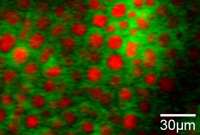New label-free method tracks molecules and drugs in live cells

A new type of highly sensitive microscopy developed by researchers at Harvard University could greatly expand the limits of modern biomedical imaging, allowing scientists to track the location of minuscule metabolites and drugs in living cells and tissues without the use of any kind of fluorescent labeling.
The technique, based on stimulated Raman scattering (SRS), works by detecting the vibrations in chemical bonds between atoms. SRS microscopy could provide scientists with a potent new form of real-time, three-dimensional bioimaging free of fluorescent labels that can hinder many biological processes.
The work is described this week in the journal Science by a team led by Harvard's X. Sunney Xie, Christian W. Freudiger, and Wei Min.
"SRS microscopy is a big leap forward in biomedical imaging, opening up real-time study of metabolism in living cells," says Xie, professor of chemistry and chemical biology in Harvard's Faculty of Arts and Sciences. "We've already used the technology to map lipids in a live cell, and to measure diffusion of medications in living tissue. These are just two early examples of how SRS microscopy may impact cell biology and medicine."
Xie, Freudinger, and Min's mapping of saturated and unsaturated fats in live cells offers exciting new opportunities for metabolic studies of omega-3 fatty acids, required but not produced by the human body. Despite a growing body of evidence suggesting that omega-3 fatty acids provide many health benefits such as dampening inflammation, lowering blood triglyceride levels, and killing cancer cells, almost nothing is known about how fats like omega-3 are actually processed by our bodies.
"Our diets have changed greatly in recent decades," Xie says. "As a unique technology capable of observing fat distribution in live cells -- and of differentiating between types of fat -- SRS microscopy could prove useful in helping understand and treat the growing imbalance of saturated and unsaturated fats in our diets."
SRS microscopy could also prove useful in neuroimaging, since neurons are coated with fatty myelin sheaths.
The researchers' use of SRS microscopy to analyze skin tissue could also open new frontiers in drug development. Xie and colleagues used SRS microscopy to view how well retinoic acid, a topical acne medication, is absorbed into skin cells. They also used the technique to capture deep-skin penetration by dimethyl sulfoxide (DMSO), a compound added to many topical medications and ointments to enhance absorption.
Scientists currently use a variety of techniques to visualize biomolecules, but most have significant limitations that are sidestepped by SRS microscopy.
A jellyfish protein first discovered in 1962, green fluorescent protein (GFP), is now used extensively as a label for observing the activity of biomolecules. GFP labeling provides sharp images, but the bulky protein can perturb delicate biological pathways, especially in cases where its heft overwhelms smaller biomolecules. Also, GFP's characteristic glow subsides with time, making it infeasible for long-term tracking.
Much like SRS microscopy, conventional infrared (IR) and Raman microscopies measure the vibrations of chemical bonds between atoms. But they are low-sensitivity imaging techniques, and require either desiccated samples or high laser power, which limits use in imaging live specimens. Coherent anti-Stokes Raman scattering (CARS) microscopy, a field pioneered by Xie's own group, cannot provide clear enough contrast for most molecules.
Source: Harvard University















